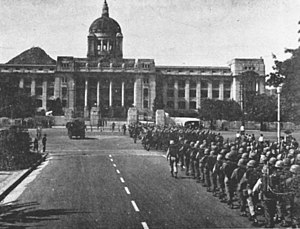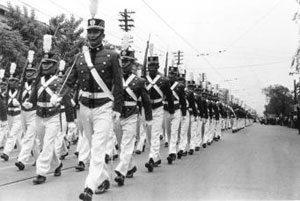
Back انقلاب 16 مايو Arabic Taol-Stad ar 16 a viz Mae Breton Golpe de Estado del 16 de mayo Spanish Coup d'État de 1961 en Corée du Sud French Kudeta 16 Mei ID Colpo di Stato in Corea del Sud del 1961 Italian 5・16軍事クーデター Japanese 5·16 군사정변 Korean 16. maija apvērsums (Koreja) Latvian/Lettish Rampasan kuasa 16 Mei Malay
| May 16 coup | |||||||
|---|---|---|---|---|---|---|---|
|
From top to bottom, Major-General Park Chung Hee (front center) and soldiers tasked with effecting the coup, South Korean Marines march to the capitol after the coup, and officer cadets of Korea Military Academy march in support of the military coup | |||||||
| |||||||
| Belligerents | |||||||
|
|
| ||||||
| Commanders and leaders | |||||||
|
| ||||||
| May 16 Coup | |
| Hangul | 5·16 군사정변 |
|---|---|
| Hanja | 五一六軍事政變 |
| Revised Romanization | O-illyuk gunsa jeongbyeon |
| McCune–Reischauer | O-illyuk kunsa chŏngbyŏn |
The May 16 military coup d'état (Korean: 5·16 군사정변) was a military coup d'état in South Korea in 1961, organized and carried out by Park Chung Hee and his allies who formed the Military Revolutionary Committee, nominally led by Army Chief of Staff Chang Do-yong after the latter's acquiescence on the day of the coup. The coup rendered powerless the democratically elected government of Prime Minister Chang Myon and President Yun Posun, and ended the Second Republic, installing a reformist military Supreme Council for National Reconstruction effectively led by Park, who took over as chairman after Chang's arrest in July.
The coup was instrumental in bringing to power a new developmentalist elite and in laying the foundations for the rapid industrialization of South Korea under Park's leadership, but its legacy is controversial for the suppression of democracy and civil liberties it entailed, and the purges enacted in its wake. Termed the "May 16 Military Revolution" by Park and his allies, "a new, mature national debut of spirit",[1] the coup's nature as a "revolution" is controversial and its evaluation contested.
- ^ Jager 2003, p. 79.


